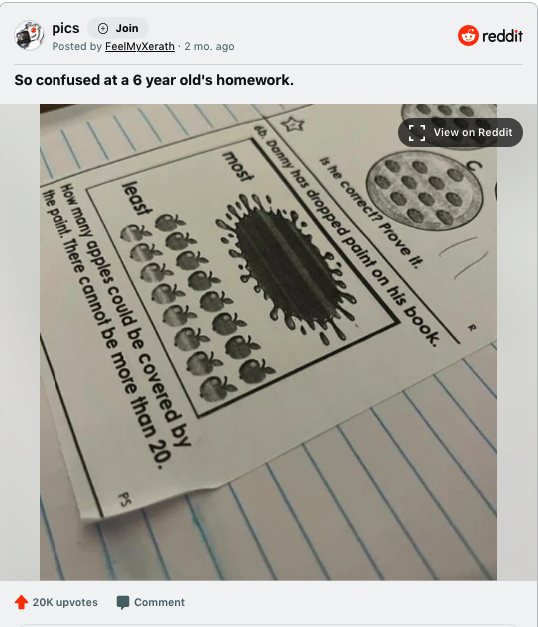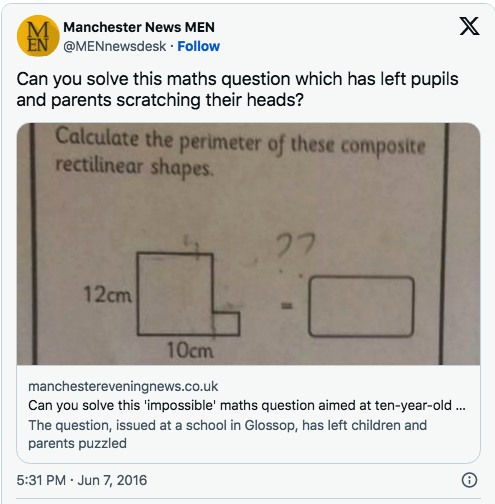7 Puzzling Homework Questions That Baffle Grown-Ups
Numerous parents posted their children’s perplexing homework questions, prompting them to seek assistance. Thankfully, the online communities on Reddit and Twitter stepped in, offering their insights.
As students progress through their education, the complexity of assigned work tends to increase. Nevertheless, there are occasions when children are presented with particularly intricate homework.
In these situations, parents often turn to the online community for support in finding solutions for their youngsters. These puzzling homework challenges are frequently shared on platforms such as Reddit and Twitter.
Grade 1 English

A mother found herself perplexed by her first-grade son’s English homework, which required him to encircle photos sharing the same ending sound as a fish’s fin. However, the available options presented a challenge, featuring a hamburger bun, a frog, a jar lid, and a spoon—none of which seemed directly related to a fish’s fin.
Reddit users came to the aid of the bewildered mother, suggesting that the ending sound didn’t necessarily have to rhyme with “fin.” Some proposed answers like “bun” and “spoon,” emphasizing that both words concluded with an “n.”
Kindergarten School Work

Typically, kindergarten homework questions are straightforward with a bit of adult assistance. Nevertheless, one parent found themselves stumped when trying to come up with the three-letter word needed to identify the image on their child’s activity sheet. The picture depicted a rabbit with her playful bunnies.
Luckily, a helpful Reddit user suggested the optimal solution: “pet.” They explained that worksheets of this nature often aim to add a challenge by altering the letter sound and placing it at the end of the word to potentially confuse the child.
Grade 3 Math Problem

Elementary math problems typically involve straightforward computations with all the necessary numbers provided. However, a Grade 3 student faced a puzzling question: “Janell had 15 marbles. She lost some of them. How many does Janell have now?”
One Reddit user proposed that the answer was less than 15 but questioned the fairness of such a query for a third-grader. Others suggested responses in line with the question’s ambiguity, such as “Janell lost her marbles.” Another user humorously remarked, “She has some left.” The varying interpretations reflected the challenge posed by the open-ended nature of the question.
A Six-Year-Old’s Homework

Some educational problems designed for six-year-olds are typically visual and straightforward. However, one student’s assignment proved challenging for her parents. The activity sheet featured a paint splatter and several apples.
The question posed was, “How many apples could be covered by the paint? There cannot be more than 20.” The perplexity of the question extended to several Reddit users, with one speculating that it might be a riddle. The ambiguity of the task left both parents and online participants scratching their heads.
Grade 1 Math

A Twitter user posted a challenging Singaporean math problem designed for first-grade students that appeared nearly impossible to solve. Despite the difficulty, one individual managed to find a solution, albeit with a slight modification to the original question.
Another Math Problem

On Twitter, a perplexing math question was shared, causing confusion among readers. The question tasked students with calculating the perimeter of a shape based on the measurements of another rectilinear shape.
In response, one person provided a complex answer and sarcastically commented, “It’s very much justified to ask these to a [ten-year-old].” The implication is that the question’s level of difficulty may be considered too advanced for the specified age group.
Solving for X

The intricacies of math often come with a single solution, but a particular math problem stumped the Twitter community with its complexity.
The problem stated, “An orchestra of 120 players takes 40 minutes to play Beethoven’s 9th Symphony. How long would it take for 60 players to play the symphony? Let P be the number of players and T the time playing.” While the question proved challenging, one Twitter user responded with a perspective from a performer’s point of view:
“The math is irrelevant in the case of this Beethoven 9 problem. As a performer who has performed it many times, the speed of the symphony is NOT a function of the number of musicians performing it.”
This emphasized that the real-world aspects of musical performance may not align with the mathematical considerations presented in the question.



